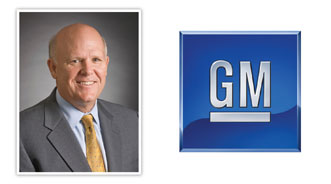Akerson Says GM Will Keep Production Going Despite Japanese Part Disruption

In a speech last week to the Society of Automotive Engineers 2011 World Congress, Dan Akerson called General Motors’ ability to keep operating efficiently despite part shortages from Japan “something of an engineering feat in its own right.”
GM’s chairman and chief executive officer began by describing his relatively short tenure in the auto industry as a big challenge.
“But if I’ve learned anything in my time at GM, it’s that this industry has a remarkable ability to adapt. The most recent example, of course, is the unfolding tragedy in Japan,” Akerson noted, referring to the earthquakes that have rocked the Asian nation since March 11.
“The human suffering there is incalculable, and our thoughts and prayers go out to the people of Japan and to our friends in the Japanese auto industry,” he continued.
“Meantime, the work that has gone into keeping our supply chain intact and our operations running has been remarkable — something of an engineering feat in its own right,” Akerson emphasized.
GM had to temporarily stop production at its Shreveport Assembly plant in Louisiana. However, Akerson remained upbeat about how the automaker could handle any supply disruptions going forward.
“Over the last five weeks, we’ve all been affected. We’re all feeling it. But based on what we’ve seen so far, I’m confident we’ll continue to work through it, continue to adapt and respond as necessary and ultimately emerge from this crisis stronger than ever,” Akerson declared.
“Today, I challenge all of us — through our companies, our communities and SAE — to harness the same spirit of determination we’re seeing today in Japan to facilitate the future transformation of the auto industry at large,” he went on to say.
Emphasis on Vehicle Technology
Since he was speaking to a gathering of engineers, Akerson took the opportunity to highlight what kinds of research and development GM has undertaken, especially with the demand for more fuel-efficient vehicles.
The top executive said GM is working to bring a number of new-vehicle and powertrain technologies to market, including:
—Advances in aerodynamics and mass reduction.
—Improvements in conventional powertrains.
—Development of alternative fuels.
—Electrification of the automobile.
Akerson stressed that electrification could come through the development of more elements that are crucial to getting more of these kinds of units in the market, including:
—A variety of hybrid systems.
—Extended-range electric vehicles.
—Battery electric vehicles.
—Ultimately, fuel-cell electric vehicles.
“At this point, we believe there is no one solution that addresses all the challenges facing societies around the world,” Akerson surmised. “And make no mistake, the clamor for cleaner, more fuel-efficient vehicles is universal. It’s as strident in Dubai as it is in Detroit, as vocal in Sao Paulo as it is in Shanghai.”
CEO Describes Pathway to Better Vehicles
In order for GM and other automakers to achieve the goals of more fuel-efficient vehicles, Akerson thinks companies will need to call upon three areas — investment, standards and education.
“These are three areas where I believe we all can work together,” he interjected.
Under the area of investment, Akerson pointed out how GM poured more than $700 million in recent years into Michigan facilities to bring the Chevrolet Volt to market. He also mentioned how GM announced last November that the company plans to hire 1,000 new engineers and researchers in Michigan during the next two years to significantly expand electric vehicle programs.
In regard to standards, that’s an area where Akerson sought the assistance of SAE to boost the potential for electric vehicles and more.
“It’s very important that we work together with SAE to develop and promote common standards for the industry as a whole,” Akerson stated. “Common standards allow the industry to achieve better results sooner and more efficiently and accelerate acceptance of new products by the public at large.
“If we have to focus on meeting many different standards, we will fragment our engineering efforts and make it harder to achieve the results we all want to see,” he warned.
“Of course, the beauty in all this is that SAE already has the desire and the wherewithal to make it happen,” Akerson acknowledged. “Let’s work together, let’s work through SAE, and let’s establish the standards that facilitate the EV industry we all want to see.”
Finally under the umbrella of education, Akerson fears a shortage of U.S. engineers is imminent, and said “it threatens to undermine our industry’s and our nation’s ability to compete in the global economy.”
To buck that trend, Akerson highlighted the financial pledges GM has made toward education outlets that emphasize science, technology and mathematics, a sum that’s more than $28 million.
“As an industry, I think we have a special opportunity — and a special obligation — to help address this situation,” Akerson concluded.


